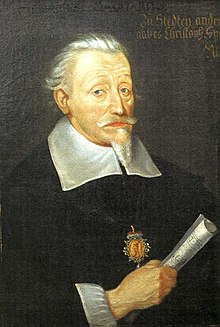Historia of the Nativity (Schütz)
The Historia of the Birth of Christ , or Christmas History for short , SWV 435, is a Historia by Heinrich Schütz , which puts the Gospel, in this case the Christmas story according to Luke and Matthew , into music for use in worship as a Gospel reading. The work was probably first performed in Dresden in 1660 and partially published in 1664.
history
The more complete work title is: Historia of the joyful and gracious birth of God and Mary's Son of Jesus Christ . Schütz had already composed a resurrection story in 1623 when he took up the position of Kapellmeister at the court of the Elector of Dresden. The Christmas music was probably performed for the first time in 1660 in the court chapel of Johann Georg II during the Christmas service. Schütz mentions the elector in the continuation of the long title: "How the same is vocaliter and instrumentaliter in the music by order of Johann Georg the Other by Heinrich Schütz".
The text of the Historia is almost exclusively taken from the Bible in the translation by Martin Luther , framed by two choral movements, the introduction and the resolution , a translation of the Christmas sequence " Grates nunc omnes " by Johann Spangenberg (1545). The biblical text of Luke includes Lk 2,1-21 LUT , that of Matthew Mt 2,1-23 LUT . The narrator is the evangelist . Other characters in the plot appear in eight sections, each designated as an intermediary : the Annunciation Angel, the Heavenly Host, the Shepherds, the Wise Men, Priests and Scribes, Herod , and an angel appearing to Joseph.
The composer agreed to a publication in 1664 containing the recitatives and the text of the other parts. An afterword, which was probably written by the Dresden cantor Alexander Hering, suggests that Schütz believed that only the “princely bands” could adequately perform the work, but he offered the other music for sale on request. This first publication later appeared in Complete Works , Volume IX, in Leipzig, edited by Julius Spitta from 1885 to 1894. Arnold Schering discovered the other voices in 1908 in the library of Uppsala University . He published it in Volume XVII of the work edition.
Cast and music
The work is composed for soloists and up to six-part choir (SSATTB) and orchestra. The Carus-Verlag published a critical edition that includes two violins , two viols , two recorders , two trumpets , two trombones and basso continuo . The performance lasts approximately 45 minutes.
The evangelist sings in a secco recitative in the dramatic Italian style, in which Schütz emphasizes individual words and uses frequent modulation to clarify what is happening. The angel is sung by a soprano accompanied by two violins, recorders characterize the shepherds. Herod is accompanied by trumpets, which stand in contrast to the violins of the angels for worldly power.
Web links
- Historia of the Birth of Jesus Christ, SWV 435 : Sheet music and audio files in the International Music Score Library Project
Individual evidence
- ^ A b Heinrich Schütz / Christmas History / Christmas History . Carus publishing house . Retrieved November 30, 2013.
- ^ A b David Vickers: Heinrich Schütz / Christmas History / Christmas History ( English ) Gramophone. Retrieved November 30, 2013.
- ↑ a b Creation of Christmas History SWV 435 . heinrich-schuetz-haus.de. Retrieved November 29, 2013.
- ↑ a b Text: Historia of the Birth of Jesus Christ, SWV 435 ( English ) San Francisco Bach Choir. Archived from the original on December 3, 2013. Info: The archive link was inserted automatically and has not yet been checked. Please check the original and archive link according to the instructions and then remove this notice. Retrieved November 30, 2013.
- ^ Neil Jenkins: Schütz The Christmas Story / Christmas History SWV 435 ( English ) Novello. 1997. Retrieved November 29, 2013.
- ↑ a b Michael Zwiebach: It's a Heinrich Schütz Christmas ( English ) San Francisco Classical Voice. December 4, 2007. Retrieved November 30, 2013.
